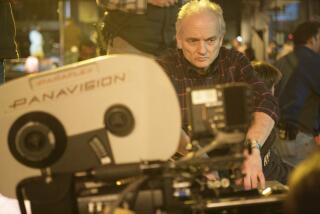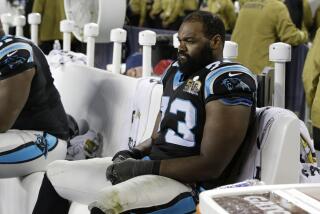‘Blind Side’ director John Lee Hancock is out of movie jail
John Lee Hancock thought he was doing a great job of racing through a day of shooting earlier this year on “The Blind Side,” the new film that stars Sandra Bullock as Leigh Anne Tuohy, a no-nonsense Memphis supermom who makes room in her life for Michael Oher, a homeless, 350-pound African American teenager who ended up becoming the Baltimore Ravens’ first-round pick in this year’s NFL draft. But when the real Leigh Anne showed up to visit the set, she found her patience flagging after a few hours.
“If I were in charge,” she told Hancock, “we’d get things done a lot faster around here.”
As it turns out, Hancock, the talented writer-director who made an impressive directorial debut in 2002 with “The Rookie,” was moving at just the right speed. Opening last weekend, “The Blind Side” has become a surprise hit, making more than $34 million and, according to CinemaScore, earning a rare A-plus from moviegoers, a reliable signal that the movie will have a long and profitable life in the multiplexes.
But “The Blind Side’s” success raises the question: What took Hancock so long to get back behind the camera? In other words, why hadn’t he made a movie since his second feature, “The Alamo,” arrived in 2004?
If you ask most people in Hollywood, they’d tell you that Hancock was in movie jail. A costly flop that ended up getting awful reviews and becoming the media’s poster film for misguided Hollywood excess, “The Alamo” was an especially painful experience for Hancock. Born and raised in Texas, he was a natural choice to salvage the film after its original director, Ron Howard, bowed out of the production over a variety of budget-related issues. But after a series of dire early screenings, Hancock was forced to make huge cuts in what was originally a nearly three-hour film, sacrificing depth and rich historical texture along the way.
When you have a flop in Hollywood, it hurts, even years later. Of course, if you’re a superstar filmmaker, whether you’re Steven Spielberg or Michael Mann or Michael Bay, you can have a flop -- even a couple of stinkers -- and still get back into the ring, bloodied but unbowed.
But directors with less invincible reputations feel a different kind of pain. If you ask Hancock, he’ll tell you that he has powder burns from “The Alamo” experience. “I’d love the opportunity to do a director’s cut of the film, because what people saw in the theaters, even though I’m proud of it, wasn’t the fully realized version of the movie. I learned that you should never take on a project where the media has decided that they already have an opinion about it. We were dogged by the same negative press that was directed at the movie before I’d even signed on to write it. The movie had just become a target, even though most of that negativity was directed at [then Disney chief] Michael Eisner.”
But Hancock insists that he never felt like he was languishing in a movie jail cell. “After ‘The Alamo’ I really wanted to get back to doing regular human being stuff, like being a dad, and the best way to do that was to stay home and write,” he told me. “So if I was in movie jail, then you’d have to say that everyone let me design the cell. I got plenty of offers to direct, just ones that weren’t right for me.”
In fact, you’d have to say that if Hancock was in movie jail, he was an awfully productive prisoner. He has a long list of post-”Alamo” projects that he’s written or rewritten scripts for or is attached to direct, including an adaptation he’s done of a contemporary Irish mob story (based on the book “Dead I Well May Be”) as well as a rewrite on “The Goree Girls,” a true-life tale about an all-female 1930s Texas prison band.
Still, it wasn’t exactly easy getting a green light for “The Blind Side.” The film is based on a popular book by Michael Lewis, which followed the Tuohy family’s relationship with Oher as well as the story behind the growing importance in the NFL of the offensive left tackle position, which had become crucial in terms of protecting quarterbacks from unseen tacklers coming from the left side of the line, known in football parlance as “the blind side.”
20th Century Fox had bought the book in fall 2006, just as it was being published. There was a serious bidding war, with Variety reporting that Fox paid $200,000 against $1.5 million if the film was made. Gil Netter, the film’s producer who had a deal at Fox, asked Hancock if he was interested in writing a script. Even though he comes from a family of Texas college football players -- his father even had a brief career in the NFL -- Hancock thought he’d sworn off doing sports films. But he was a fan of Lewis’ writing, so he read the book and was hooked.
“I didn’t see it as a sports movie at all, any more than you’d call ‘Jerry Maguire’ a sports film,” he said. “It was two equally involving stories, one about Michael and the Tuohys, the other about the left tackle position, but they both turned around the same question -- how did the stars align so brightly around this one kid from the projects?”
But Fox, it turned out, got cold feet. Hancock turned in a completed script, but the studio response was underwhelming. “I just never heard much from Fox,” he says. “I think they always looked at the movie as one of two things, either as a movie for older women or strictly a sports-genre movie, neither of which they wanted to make.”
To Fox’s credit, when Hancock and his agent, CAA’s David O’Connor, lobbied to let him find a new home for the script, the studio didn’t stand in their way. Hancock took the script to Alcon Entertainment, which years before had made “My Dog Skip,” a film Hancock had helped produce. Alcon chiefs Andrew Kosove and Broderick Johnson agreed to bankroll the project -- which cost roughly $32 million -- and Warner Bros., which works frequently with Alcon, agreed to distribute.
It was up to Hancock to find a top actress to star in the film, which led him to Sandra Bullock. Hancock thought Bullock had a lot in common with Leigh Anne Tuohy, such as both women are Southerners. “I thought that Sandra, as a Southerner, would know that Leigh Anne wasn’t a cartoon, so she wouldn’t go for the stereotype of the character,” says Hancock.
On the other hand, Bullock was initially resistant, concerned that Hancock couldn’t seem to explain what made Leigh Anne tick. So Hancock finally arranged for a meeting in Memphis between the women, which sealed the deal. “Sandra said, ‘Now I understand why you couldn’t explain her to me -- she’s just so indescribable,’” Hancock recalls.
The foundation of Leigh Anne’s relationship with Oher was even more problematic. Most moviegoers find the film inspiring for its simple message -- that someone born into poverty could blossom if given love and nourishment in a caring environment. It helped that Bullock’s Leigh Anne is the ultimate example of a popular movie heroine -- the uncomplicated striver.
But some critics were suspicious of that simplistic can-do energy, bashing the film as a paternalistic portrait of a deprived black youth being nurtured by a wealthy white lady. The New York Times’ A.O Scott says that the film offers a curious moral, “which is that the best hope for a poor black child in America is to have rich white parents.” The Chicago Tribune’s Michael Phillips complained that “at its queasiest, ‘The Blind Side’ veers perilously close to the concept of poverty tourism.”
Hancock wasn’t surprised by the criticism about the film’s paternalism, since similar accusations were leveled against Lewis’ book. “I see it differently,” the filmmaker says. “To me, this is a nature versus nurture thing. I look at it as part of the differences between being rich and being poor, not as a white-guilt form of paternalism. Any time you have people of different races in a movie that’s about America, there’s going to be a racial component. But I think I’d be a pretty wafer-thin kind of person if I worried about what critics of the story would say.”
For Hancock, there was one simple dramatic underpinning to Leigh Anne’s motivation for helping Oher when she first saw him out walking one night in the freezing rain. “From my standpoint I will only say that on that freezing night in Memphis, Leigh Anne didn’t stop the car and put Michael in the back seat because he was black. She did it because he was cold.”
patrick.goldstein@latimes .com
More to Read
Only good movies
Get the Indie Focus newsletter, Mark Olsen's weekly guide to the world of cinema.
You may occasionally receive promotional content from the Los Angeles Times.










